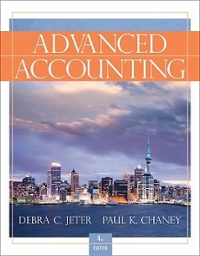Question
1. Which of the following is not true of accounts receivable? Accounts receivable is an amount owed by a customer on purchase of company products
- 1. Which of the following is not true of accounts receivable?
- Accounts receivable is an amount owed by a customer on purchase of company products or services.
- Accounts receivable is recorded at the time of sale.
- Accounts receivable is reported at net realizable value.
- Losses from the inability to collect accounts receivable are recorded in the accounting system as sales returns.
- Accounts receivable
- Net realizable value
- Sales returns
- Bad debt
Cash 245 Sales Discounts 5 Accounts Receivable 250 (To record payment) Cash 240 Sales Discounts 10 Accounts Receivable 250 (To record payment) Cash 200 Sales Discounts 50 Accounts Receivable 250 (To record payment) Cash 250 Sales Discounts 5 Accounts Receivable 245 (To record payment)
- Sales allowances
- Sales returns
- Baddebtsexpense
-
- Other expense
- The receivable is written off the companys accounting records.
- The amount is recorded as a bad debt expense.
- It accounts for the receivable with only one entry.
- All of these choices are correct.
1. The interest on a $5,400, 3%, 45-day note is
- $20.25.
- $202.50.
- $2.03.
- $19.97.
2. The journal entry to record the adjusting entry for accrued interest on a note receivable would include a
- debit to Cash.
- debit to Interest Expense.
- credit to Interest Revenue.
- debittoNotesReceivable.
1. The allowance for doubtful accounts is reported as a(n) __________ on the balance sheet.
- addition to accounts receivable
- deduction from accounts receivable
- addition to notes receivable
- deduction from trading investments
2. All receivables that are expected to be realized in cash within a year are reported in the __________ section of the balance sheet.
- Current Assets
- Investments
- Noncurrent Assets
- CurrentLiabilities
1. The accounts receivable turnover is computed as
- sales divided by accounts receivable.
- sales divided by average accounts receivable.
- sales divided by net income.
- None of these choices are correct.
2. The number of days' sales in receivables is calculated as
- sales divided by accounts receivable.
- average accounts receivable divided by average daily sales.
- sales divided by net income.
- Noneofthesechoicesarecorrect.
| Apr. | 2. | Sold merchandise on account to Peking Palace Co., $36,730. The cost of the merchandise sold was $25,310. |
| June | 9. | Received $11,950 from Peking Palace Co. and wrote off the remainder owed on the sale of April 2 as uncollectible. |
| Oct. | 31. | Reinstated the account of Peking Palace Co. that had been written off on June 9 and received $24,780 cash in full payment. |
| 1 | A | B | C | D | E | F | G |
| 2 | Days Past Due | Days Past Due | Days Past Due | Days Past Due | |||
| 3 | Customer | Balance | Not Past Due | 1-30 | 31-60 | 61-90 | Over 90 |
| 4 | Acme Industries Inc. | 2,600.00 | 2,600.00 | ||||
| 5 | Alliance Company | 4,200.00 | 4,200.00 | ||||
| 6 | ~~~~~ | ~~~~~ | ~~~~~ | ~~~~~ | ~~~~~ | ~~~~~ | ~~~~~ |
| 7 | Zollinger Company | 5,200.00 | 5,200.00 | ||||
| 8 | Subtotals | 1,051,100.00 | 597,500.00 | 223,600.00 | 114,300.00 | 85,400.00 | 30,300.00 |
| Builders Industries | $44,100 | May 1 |
| Elkhorn Company | 20,600 | June 20 |
| Granite Creek Inc. | 7,800 | July 13 |
| Lockwood Company | 13,500 | September 9 |
| Teton Company | 12,400 | August 7 |
| A. | Determine the number of days past due for each of the preceding accounts as of August 31. If an account is not past due, enter a zero. |
| B. | Complete the aging of receivables schedule by adding the omitted accounts to the bottom of the schedule and updating the totals. If an amount box does not require an entry, leave it blank. |
Step by Step Solution
There are 3 Steps involved in it
Step: 1

Get Instant Access to Expert-Tailored Solutions
See step-by-step solutions with expert insights and AI powered tools for academic success
Step: 2

Step: 3

Ace Your Homework with AI
Get the answers you need in no time with our AI-driven, step-by-step assistance
Get Started


